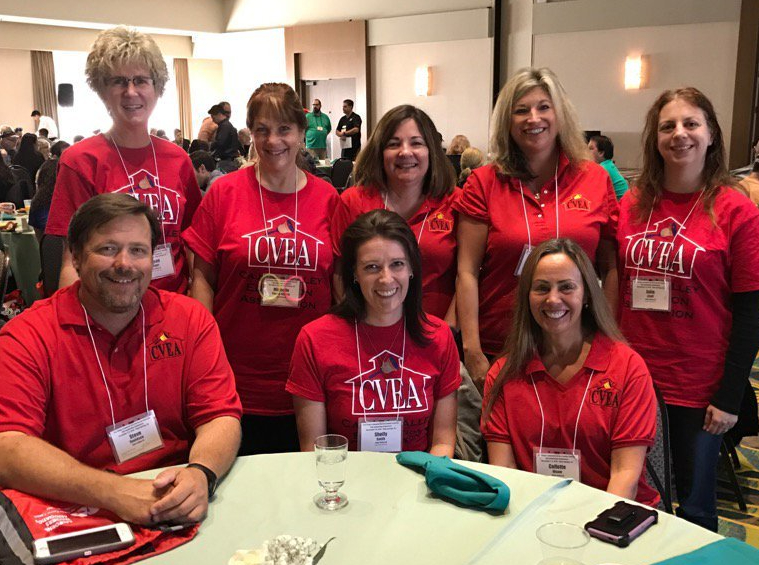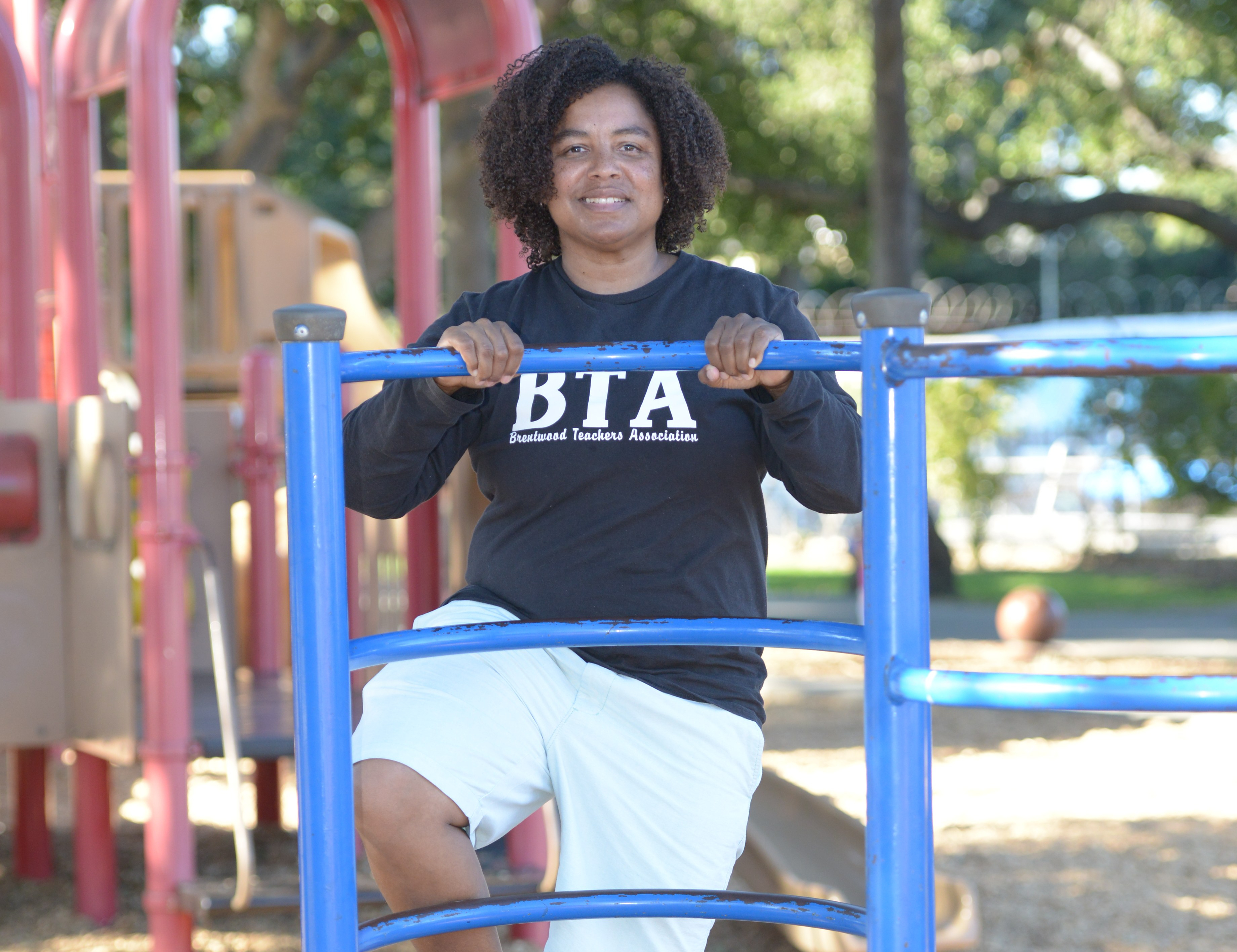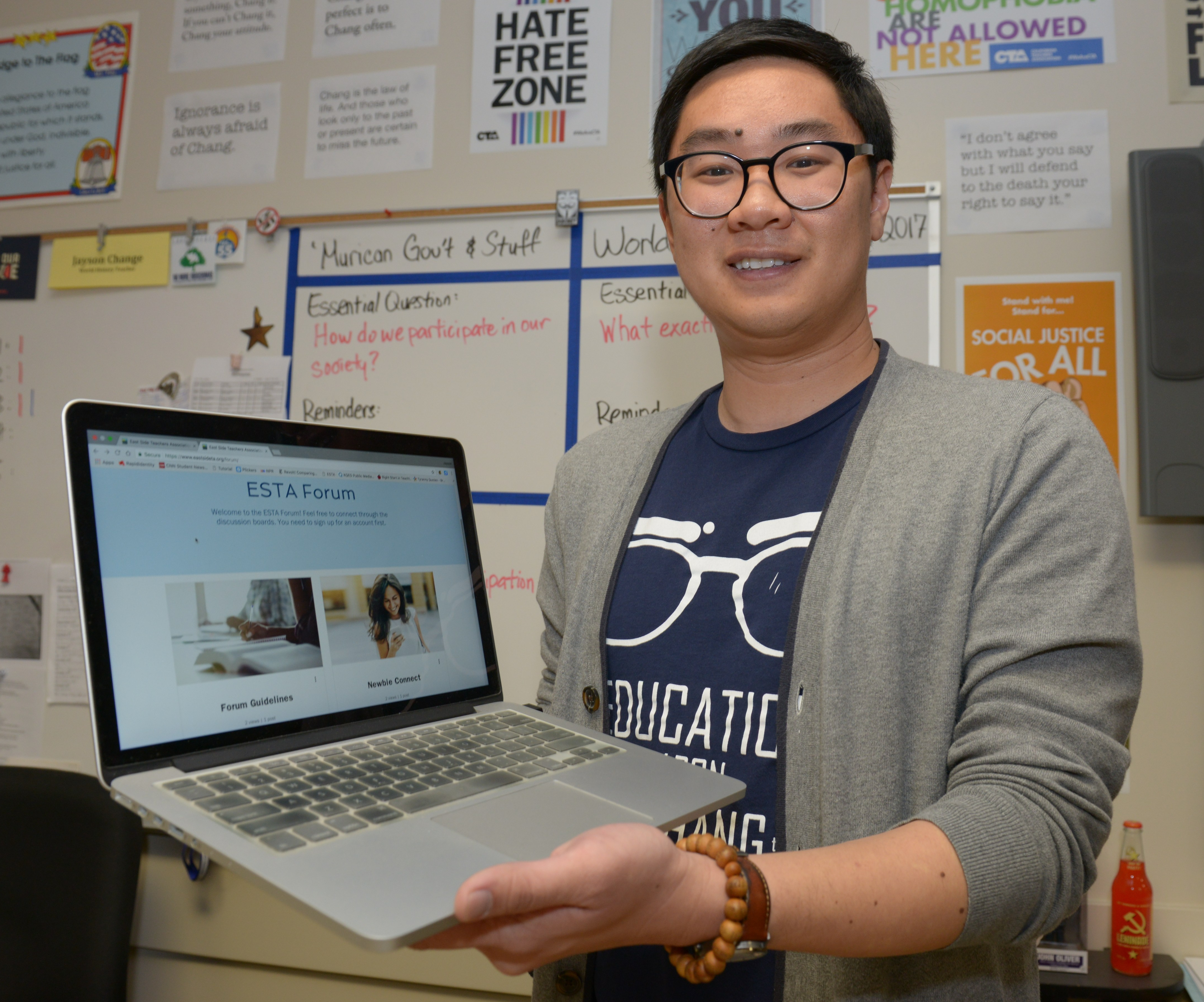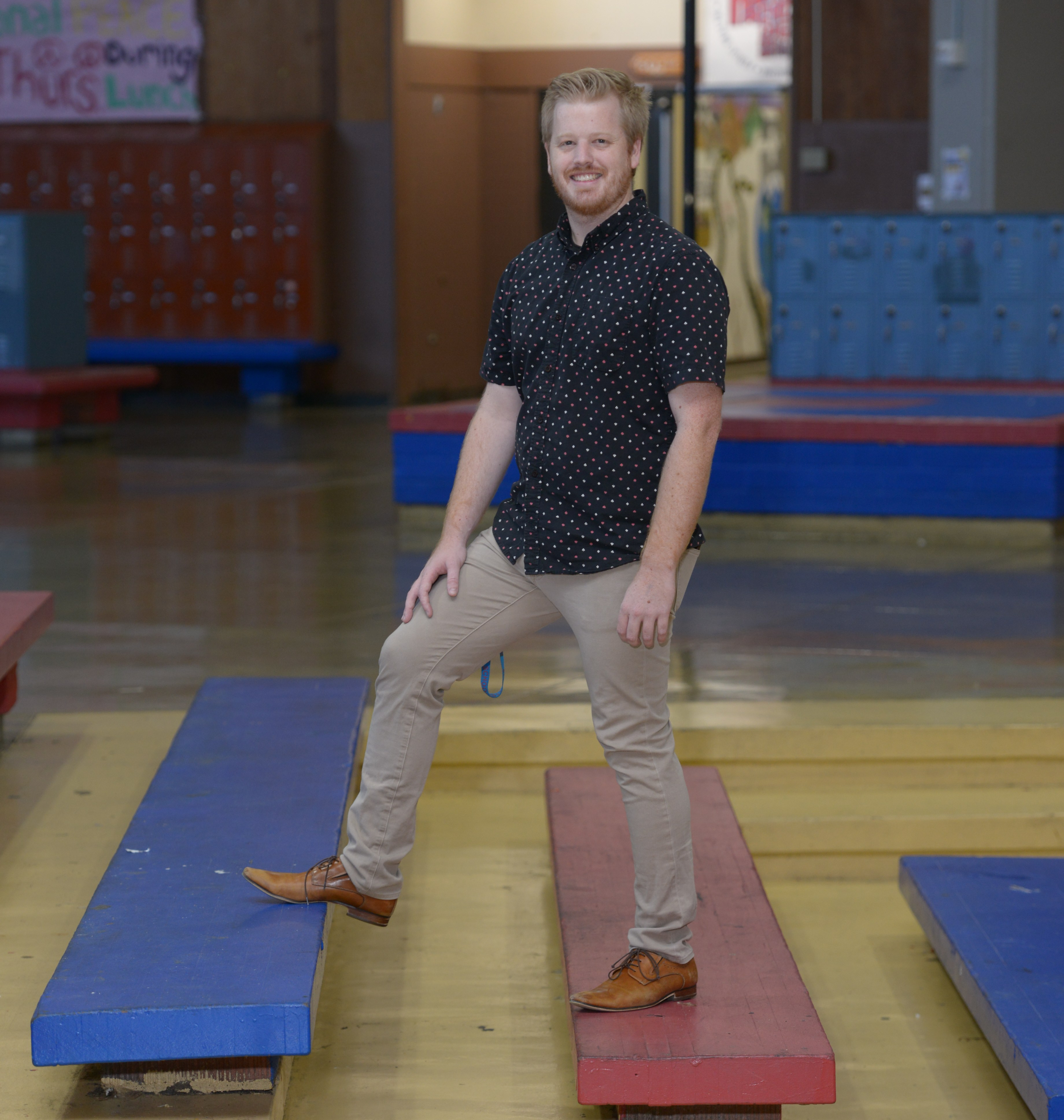Photos by Scott Buschman
“A journey of a thousand miles starts with one step.” —Lao Tzu, ancient Chinese philosopher
Want to improve your workplace? Make your voice heard? Sharpen your skill set? Make the world a better place?
You don’t have to go it alone — or all at once. With CTA’s help, even small actions can have a huge impact. It starts a step at a time.
Getting involved in CTA is a way to create positive change and advocate for things you believe in. That’s because strength in numbers allows people to accomplish more than they could individually. Bonding with colleagues and feeling a sense of empowerment from making a difference are icing on the cake.
We asked CTA members to share ways that taking “small steps” within their union improved their professional and personal lives. Here is what they have to say.
Be an advocate
Being able to advocate for teachers and students without fear of retribution was the reason that Marissa Glidden became a site rep at Verde Elementary School in Richmond. Like other site reps, she voluntarily gave her time to defend members’ rights, monitor and enforce the contract, advocate to improve working conditions, and convey members’ concerns to chapter leadership.
 “We fought for simple working conditions, such as having copiers at work,” says Glidden, United Teachers of Richmond vice president. “We fought for professional development and lower class size. We advocated for safe schools to meet the needs of students who are transgender, DACA, Muslim and being bullied. Being a rep allowed me to speak up without fear of repercussion.”
“We fought for simple working conditions, such as having copiers at work,” says Glidden, United Teachers of Richmond vice president. “We fought for professional development and lower class size. We advocated for safe schools to meet the needs of students who are transgender, DACA, Muslim and being bullied. Being a rep allowed me to speak up without fear of repercussion.”
When teachers improve their work environments, it benefits students, observes Glidden, a fifth-grade teacher, because districts can better attract and retain educators.
“In the past, we were not always heard. Once I got involved, I felt like I was part of a big group of people who believe teachers deserve good working conditions and students deserve good learning conditions. It was very inspiring.”
She was pleased the union came to her rescue when she discovered she wasn’t being paid what she was worth after earning a master’s degree.
“Human Resources said I had never turned the form in and wouldn’t budge. I tried to stay calm. Then someone from the union reached out, and I was taken care of immediately. The union had my back. They listened and made me feel valued.”
Being an advocate is nice, but so is a sense of camaraderie, says Glidden.
“We have created community. It feels great to be part of something that’s bigger than ourselves.”
Find a voice
Shelly Smith began teaching in the state-funded preschool program in 2005. As a member of the Cajon Valley Education Association, she paid dues but was not active.

Shelly Smith, front row center, with CVEA colleagues.
“I didn’t know about what the union did or the benefits of being a member. I didn’t really have an opinion. So many things were new to me. The union wasn’t on my radar.”
That changed in 2010, when all 23 preschool teachers in the Cajon Valley Union School District and others received pink slips.
“Our union fought for our rights, right alongside us, and almost all of the preschool teachers were reinstated. From that moment on, I became active in our union.”
That year she became a site rep, continuing in the role for six more. She moved from preschool to teaching transitional kindergarten and then first grade, because the bargaining team and the assistant superintendent created a memorandum of understanding allowing the transfer. She joined the CVEA executive board a few years ago and is also on the bargaining team.
“Throughout this journey, I have been fortunate to build relationships with union leadership, staff at my site, principals and district representatives, and as a result I have grown as a person and an educator,” says Smith, a teacher at Meridian Elementary School. “I have found the strength in my own voice. I feel empowered to speak up not just for myself, but others. People listen to what I have to say, and I feel valued.”
Her advice for those considering union involvement?
“Go for it. It’s totally worth it to have a voice.”
Stand up for human rights
When teachers in Brentwood formed the Brentwood Teachers Association five years ago, Angela Normand became a site rep at J. Douglas Adams Middle School. But the special day class teacher was not particularly vocal.
 “I was a very quiet, silent site rep. I made a lot of copies and took a lot of notes and blended into the background.”
“I was a very quiet, silent site rep. I made a lot of copies and took a lot of notes and blended into the background.”
When she learned BTA was looking for a human rights contact, she signed up. At CTA trainings she learned about unconscious bias, or stereotypes about certain groups of people that individuals form outside their own conscious awareness. She became more informed about women’s rights and the ongoing struggles for equal economic opportunities, educational equity, and an end to gender-based violence.
“I could not believe how much CTA cared about human rights, not only for our students, but educators,” says Normand. “It was mind-blowing.”
Normand brought back what she learned to colleagues: Standing up for human rights means providing a quality education for all students, showing respect and dignity for all students and teachers, recruiting and retaining a diverse teaching force, providing education on human and civil rights issues, and empowering diverse communities to take part in educational decisions.
While attending a CTA conference, she peeked into CTA’s Ethnic Minority Early Identification and Development (EMEID) leadership program and applied. Once accepted, she was paired with a mentor who encouraged her to take on more. She joined State Council as the minority-at-large rep for Alcosta Service Center, was elected vice president of her chapter, became chair of the African American Caucus, and became a member of the Ethnic Minority Affairs Committee.
“Working with a group of individuals who hold the same ideals as you can forge the way for the best possible outcomes in transforming school culture into a place where students succeed and do what they are capable of,” says Normand. “For me, nothing is more gratifying.”
Find and give support
Last year, Jayson Chang, a new social studies teacher at Santa Teresa High School in San Jose, went it alone.

Jayson Chang shows the ESTA website he created.
“I knew next to nothing about unions and CTA,” recalls Chang. “I told myself I was just trying to survive in my classroom.”
When he realized that CTA was there to offer support and help new teachers survive, it made a world of difference.
“I attended the Good Teaching Conference North and discovered CTA has a plethora of resources — trainings, professional development, lesson planning — to support me when I need it,” says the East Side Teachers Association member. “This support helped me to stay afloat.”
Union support — and concern over Betsy DeVos’ appointment as secretary of education — prompted him to become active. He became ESTA’s webmaster and is revamping the website to increase awareness of the benefits of union involvement, as well as building community on Facebook and Twitter. He is also helping Santa Clara County Service Center Council increase its online presence.
The millennial educator is working with his chapter’s member engagement committee to create a new teacher subcommittee.
“I want to help build a bridge between our local association and members who are new to the profession or are just coming into the district,” says Chang. “I would like this committee to serve as a resource and information hub to new members, with the long-term goal of grooming new leadership. I think connecting new members with our union can increase retention and decrease burnout and turnover.”
He envisions creating a Google Drive site that’s a “one-stop shop kind of place” where members find resources, support and more through collaboration and sharing.
“I’m excited about connecting with new members and letting them know the union is here to support them,” says Chang. “It’s so much easier when you realize you don’t have to go it alone.”
Become an agent of change
Jacob Gran has been teaching special education at Richmond High School for four years, and has been the department chair for three. After United Teachers of Richmond members voted in a new leadership team, Gran wanted to be part of the transformation, so he became a site rep.
 “We had new, fresh leadership, and it was a different vibe,” says Gran. “I wanted to become involved in the new direction our union was taking.” He describes that as being more collaborative with administrators and school board members, so educators are partners rather than adversaries.
“We had new, fresh leadership, and it was a different vibe,” says Gran. “I wanted to become involved in the new direction our union was taking.” He describes that as being more collaborative with administrators and school board members, so educators are partners rather than adversaries.
“It doesn’t mean we don’t disagree with the district, but it’s important to have a relationship. Without infighting, there’s potential for real change, and it benefits both teachers and students.”
And changes are being made. During an informal discussion about class size last year, a timeline was set to reduce the number of students in crowded classrooms, and it eventually happened. UTR collaborated with the school board, community organizations and families to get a “Safe Haven Resolution” passed, which protects undocumented students, families and staff.
In November 2016, Gran was elected to CTA State Council, and the millennial teacher is now part of his chapter’s negotiating committee and executive board. He is involved in plans to survey members online about their needs and how chapter leadership can best meet those needs.
Teaching can be isolating, he observes, because teachers tend to stay in their classrooms. That, in turn, can lead to feelings of powerlessness, a belief that nothing will ever change.
“But when you get involved in your union, things happen,” he says. “You realize you aren’t alone. You meet cool people. And you discover: Together, you make a difference.”
The Discussion 0 comments Post a Comment